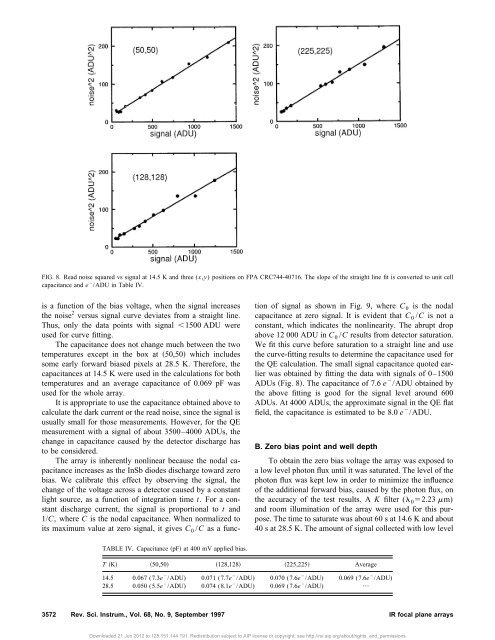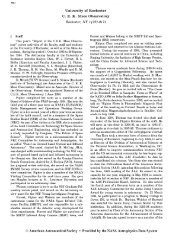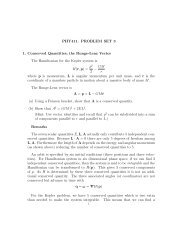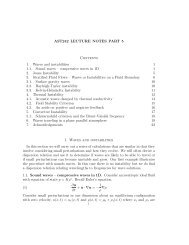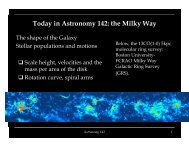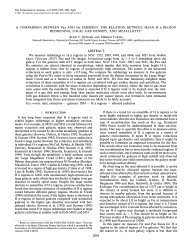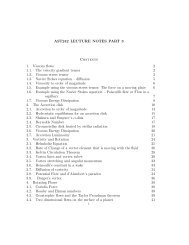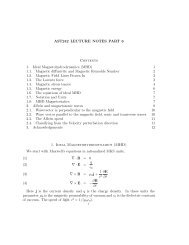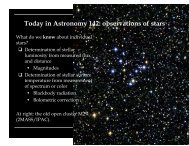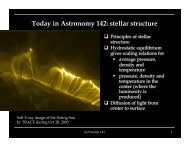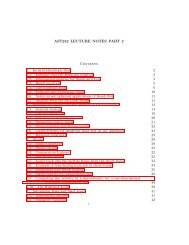Development of infrared focal plane arrays for space - Astro Pas ...
Development of infrared focal plane arrays for space - Astro Pas ...
Development of infrared focal plane arrays for space - Astro Pas ...
You also want an ePaper? Increase the reach of your titles
YUMPU automatically turns print PDFs into web optimized ePapers that Google loves.
FIG. 8. Read noise squared vs signal at 14.5 K and three (x,y) positions on FPA CRC744-40716. The slope <strong>of</strong> the straight line fit is converted to unit cellcapacitance and e /ADU in Table IV.is a function <strong>of</strong> the bias voltage, when the signal increasesthe noise 2 versus signal curve deviates from a straight line.Thus, only the data points with signal 1500 ADU wereused <strong>for</strong> curve fitting.The capacitance does not change much between the twotemperatures except in the box at 50,50 which includessome early <strong>for</strong>ward biased pixels at 28.5 K. There<strong>for</strong>e, thecapacitances at 14.5 K were used in the calculations <strong>for</strong> bothtemperatures and an average capacitance <strong>of</strong> 0.069 pF wasused <strong>for</strong> the whole array.It is appropriate to use the capacitance obtained above tocalculate the dark current or the read noise, since the signal isusually small <strong>for</strong> those measurements. However, <strong>for</strong> the QEmeasurement with a signal <strong>of</strong> about 3500–4000 ADUs, thechange in capacitance caused by the detector discharge hasto be considered.The array is inherently nonlinear because the nodal capacitanceincreases as the InSb diodes discharge toward zerobias. We calibrate this effect by observing the signal, thechange <strong>of</strong> the voltage across a detector caused by a constantlight source, as a function <strong>of</strong> integration time t. For a constantdischarge current, the signal is proportional to t and1/C, where C is the nodal capacitance. When normalized toits maximum value at zero signal, it gives C 0 /C as a function<strong>of</strong> signal as shown in Fig. 9, where C 0 is the nodalcapacitance at zero signal. It is evident that C 0 /C is not aconstant, which indicates the nonlinearity. The abrupt dropabove 12 000 ADU in C 0 /C results from detector saturation.We fit this curve be<strong>for</strong>e saturation to a straight line and usethe curve-fitting results to determine the capacitance used <strong>for</strong>the QE calculation. The small signal capacitance quoted earlierwas obtained by fitting the data with signals <strong>of</strong> 0–1500ADUs Fig. 8. The capacitance <strong>of</strong> 7.6 e /ADU obtained bythe above fitting is good <strong>for</strong> the signal level around 600ADUs. At 4000 ADUs, the approximate signal in the QE flatfield, the capacitance is estimated to be 8.0 e /ADU.B. Zero bias point and well depthTo obtain the zero bias voltage the array was exposed toa low level photon flux until it was saturated. The level <strong>of</strong> thephoton flux was kept low in order to minimize the influence<strong>of</strong> the additional <strong>for</strong>ward bias, caused by the photon flux, onthe accuracy <strong>of</strong> the test results. A K filter ( 0 2.23 m)and room illumination <strong>of</strong> the array were used <strong>for</strong> this purpose.The time to saturate was about 60 s at 14.6 K and about40 s at 28.5 K. The amount <strong>of</strong> signal collected with low levelTABLE IV. Capacitance pF at 400 mV applied bias.T K 50,50 128,128 225,225 Average14.5 0.067 (7.3e /ADU) 0.071 (7.7e /ADU) 0.070 (7.6e /ADU) 0.069 (7.6e /ADU)28.5 0.050 (5.5e /ADU) 0.074 (8.1e /ADU) 0.069 (7.6e /ADU) •••3572 Rev. Sci. Instrum., Vol. 68, No. 9, September 1997 IR <strong>focal</strong> <strong>plane</strong> <strong>arrays</strong>Downloaded 21 Jun 2012 to 128.151.144.191. Redistribution subject to AIP license or copyright; see http://rsi.aip.org/about/rights_and_permissions


